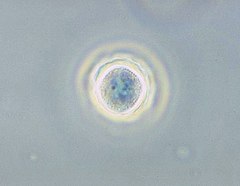fi
nimet breadcrumb-navigoinnissa

Acanthamoebidae is a family of single-celled eukaryotes within the group Amoebozoa.
It gets its name from Acanthamoeba, its best-known member. However, it also includes other species, such as Comandonia operculata and Protacanthamoeba bohemica.[1] Many kinds of Acanthamoebidae are highly prevalent in the soil and water of a variety of environments.[2][3] They are similar to Hartmannella, but have differently structured pseudopodia, in regard to the actin microfilaments that comprise them. Its most prominent member, Acanthamoeba, can be potentially pathogenic to humans and animals.[3]
It has been described as having a common origin with the Entamoebidae and Dictyosteliida.[4]
Members of Acanthamoebidae have a specific form of pseudopodia, dubbed acanthopodia.[5] These acanthopodia are continuously formed and reabsorbed, protrude from every area of the cell’s surface, and are usually, short and fine. An exception would be A. astronyxis and A. comandoni, in which the acanthopodia may be quite long.[5] Sawyer and Griffin point out “[b]undles of actin microfilaments extend as rigid cores into acanthopodia”.[5] They are constantly formed and reabsorbed to induce locomotion, during which time the cell is typically triangular or cone-shaped.[5] The advancing acanthopodia are “wide and tongue-shaped, with irregular margins and filopodia.”[5] Sawyer and Griffin also note that the many acanthopodia contain axial bundles of the actin microfilaments, resulting in the irregular shape of the pseudopodia.[5] In regards to the typical physical size of the family Acanthamoebidae, they rarely grow larger than 65 µm or are smaller than 30 µm.[5]
The family Acanthamoebidae belongs to the order Centramoebida in the class Discosea, phylum Amoebozoa.[6] Within the family Acanthamoebidae are the following genera:[7]
Members of Acanthamoebidae are highly prevalent in a variety of environments. In Osaka Prefecture, Japan, members (as well as Naegleria) were found in 68.7% of tapwater samples taken, despite purification.[2] Acanthamoebidae were also found in the St. Martin River near Ocean City, Maryland, and are very common in the surface waters of many oceans.[3]
Acanthamoeba spp. can be potentially pathogenic to humans and animals.[3] Typically, a person or animal with a normally functioning immune system can avoid infection, but they "are known to be the opportunistic pathogens in granulomatous amoebic encephalitis (GAE), a chronic disease of immunocompromised hosts such as AIDS patients and transplants recipients.”[2] GAE is the result of microscopic cysts that form in the central nervous system. Acanthamoeba can also be the source of infections in the lungs, sinuses, skin, and eyes.[2]
Acanthamoebidae is a family of single-celled eukaryotes within the group Amoebozoa.
It gets its name from Acanthamoeba, its best-known member. However, it also includes other species, such as Comandonia operculata and Protacanthamoeba bohemica. Many kinds of Acanthamoebidae are highly prevalent in the soil and water of a variety of environments. They are similar to Hartmannella, but have differently structured pseudopodia, in regard to the actin microfilaments that comprise them. Its most prominent member, Acanthamoeba, can be potentially pathogenic to humans and animals.
It has been described as having a common origin with the Entamoebidae and Dictyosteliida.
Acanthamoebidae is een familie in de taxonomische indeling van de Amoebozoa. Deze micro-organismen hebben geen vaste vorm en hebben schijnvoetjes. Met deze schijnvoetjes kunnen ze voortbewegen en zich voeden.[1]
Bronnen, noten en/of referenties Systematyka Domena Eukarionty Supergrupa Amoebozoa Podtyp Lobosa Gromada Discosea Podgromada Longamoebia Rząd Centramoebida Rodzina Acanthamoebidae Nazwa systematyczna Acanthamoebidae
Systematyka Domena Eukarionty Supergrupa Amoebozoa Podtyp Lobosa Gromada Discosea Podgromada Longamoebia Rząd Centramoebida Rodzina Acanthamoebidae Nazwa systematyczna Acanthamoebidae Acanthamoebidae – rodzina ameb należących do supergrupy Amoebozoa w klasyfikacji Cavaliera-Smitha[1].
Należą tutaj następujące rodzaje:
Acanthamoebidae – rodzina ameb należących do supergrupy Amoebozoa w klasyfikacji Cavaliera-Smitha.
Należą tutaj następujące rodzaje:
Acanthamoeba Protacanthamoeba
가시아메바과(Acanthamoebidae)는 아메바류에 속하는 단세포 진핵생물 과이다.[1][2] 가장 잘 알려진 종은 가시아메바속에 속하는 종이다. 많은 종류의 가시아메바류가 다양한 환경의 물과 토양에 널리 퍼져 있다.[3]